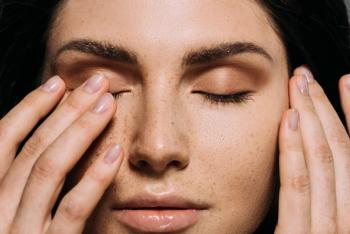
Nonsteroidal Topical Therapies
Neal Bhatia, MD, explores steroid alternatives in his presentation at the Fall Clinical Dermatology Conference.
The growing array of topical therapies available and in development for inflammatory skin conditions may require dermatologists to shift how they think about topical treatments.
“The key is to reduce the use of the phrase ‘nonsteroidal alternatives’ and start to think of nonsteroidal approaches, or even mechanisms that address the disease process,” said Neal Bhatia, MD, director of clinical dermatology at Therapeutics Clinical Research in San Diego, California, at the Fall Clinical Dermatology Conference, held October 21 to 24, in Las Vegas, Nevada, and virtual. “That’s where some of these new topical therapies are headed.”1
When topical calcineurin inhibitors (TCIs) debuted, he said, dermatologists thought in terms of steroid alternatives. “Now, phosphodiesterase 4 (PDE4) inhibitors, JAK inhibitors, and tapinarof are all dedicated approaches to the disease process,” he said.
Several new compounds under development avoid the atrophy, tachyphylaxis, and tolerability issues associated with steroids while offering versatility for treating multiple disease states, he said. “The best potential indications down the road for these therapies include vitiligo and alopecia areata (AA), where we haven’t had successful or safe management strategies for areas such as the face or scalp,” Bhatia explained.
In September 2021, the JAK1/2 inhibitor ruxolitinib 1.5% cream (Opzelura; Incyte) earned FDA approval for short-term use in mild to moderate atopic dermatitis (AD) in patients at least 12 years old. The drug also possesses significant potential for patients with vitiligo and AA, Bhatia said. In a 57-patient dose-ranging study, 30% of patients with vitiligo achieved 75% reductions in Vitiligo Area Scoring Index scores at week 24.2
“Even after a year,” Bhatia added, “almost 50% of patients achieved a 75% improvement in their vitiligo. Those are numbers we haven’t had before. That’s very encouraging for the long run.”
One day, he said, dermatologists could offer treatment that is safe for patients—who typically use intralesional steroids, long-term topical steroids, and/or TCIs, with little relief—to use for a year without safety concerns.
Regarding the PDE4 inhibitor roflumilast, Bhatia said, future indications could include AD, psoriasis, and seborrheic dermatitis. In 2 phase 3 psoriasis cohorts, the proportions of patients on roflumilast cream 0.3% who achieved investigator ratings of clear or nearly clear (with 2-grade improvement) remained consistent for up to 64 weeks, with safety and tolerability similar to those of vehicle.3
The ayrl hydrocarbon inhibitor tapinarof has shown success in psoriasis4 and AD5 due to its broadly acting mechanism. In a 12-week phase 2b AD study, the most common treatment-emergent adverse events included mild to moderate folliculitis, application site pain, and AD.5
“We need safer long-term approaches for topical management, as well as short-term, immediate benefits for treating itch and controlling inflammation,” Bhatia said. Such therapies may be adjunctive to systemic or biologic therapies, he added.
Bhatia expects ruxolitinib, roflumilast, and tapinarof to work well for patients on biologics who need spot therapy or experience breakthrough flares. The new medications are very safe, he said, “and patients still like to treat from the top down.” Even patients on systemic therapies often like applying topical medications, he explained, because they feel like they are taking an active role in their care.
References:
- Bhatia N, Stein Gold L. Unmet needs with current topical therapies for inflammatory diseases. Fall Clinical Dermatology Conference; October 21, 2021; Las Vegas.
- Rosmarin D, Pandya AG, Lebwohl M, et al. Ruxolitinib cream for treatment of vitiligo: a randomised, controlled, phase 2 trial. Lancet. 2020;396(10244):110-120. doi:10.1016/S0140-6736(20)30609-7
- Stein Gold L, Gooderham MJ, Papp KA, et al. Long-term safety and efficacy of roflumilast cream 0.3% in adult patients with chronic plaque psoriasis: results from a 52-week, phase 2b open-label study. Innovations In Dermatology Virtual Spring Conference; March 16-20, 2021.
- Lebwohl M, Stein Gold L, Strober B, et al. Tapinarof cream 1% QD for the treatment of plaque psoriasis: efficacy and safety in two pivotal phase 3 trials. Fall Clinical Dermatology Virtual Meeting; October 29-November 1, 2020.
- Peppers J, Paller AS, Maeda-Chubachi T, et al. A phase 2, randomized dose-finding study of tapinarof (GSK2894512 cream) for the treatment of atopic dermatitis. J Am Acad Dermatol. 2019;80(1):89-98.e3. doi:10.1016/j.jaad.2018.06.047
Disclosures:
Bhatia has been a speaker, investigator, and/or advisor for AbbVie, Almirall, Biofrontera, Bristol Myers Squibb, Boehringer Ingelheim, EPI Health, Ferndale, Foamix, Galderma, Incyte, ISDIN, Johnson & Johnson, LaRoche-Posay, Leo, Eli Lilly, Ortho Dermatologics, Pfizer, Procter & Gamble, Regeneron, Sanofi, Sun Pharma, VYNE Therapeutics, and Vyome Therapeutics.
Newsletter
Like what you’re reading? Subscribe to Dermatology Times for weekly updates on therapies, innovations, and real-world practice tips.

















